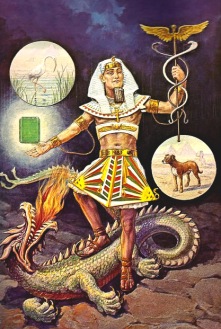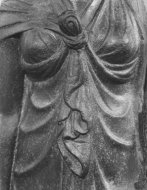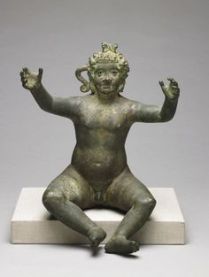We ended last time wondering whether Horus, the son and student of Isis, might be the “Pupil of the Eye of the World” rather than Isis. So let’s have a look at that.
As you already know, the Kore Kosmou is one of the Hermetica, spiritual teaching texts meant to illuminate the student. Like a number of other Hermetica, it appears to end with a significant hymn. I say “appears” because our fragmentary text ends just as Isis is about to reveal the hymn to Horus.
“Ay, mother, Horus said. On me as well bestow the knowledge of this hymn, that I may not remain in ignorance.
And Isis said: Give ear, O son! [. . . ]”
And that’s where it breaks off.
The hymn that we don’t have is the culmination of the entire text and must have had great magical/spiritual power for it is the hymn Isis and Osiris recited before They re-ascended to the heavens after having completed Their civilizing Work on earth.
I’ve been reading a paper by Jorgen Sorensen about the Egyptian background of the Kore Kosmou. He suggests that the missing hymn, combined with a secret that Isis refuses to reveal to Horus earlier in the text could be the text’s main point.
The secret comes up in Isis’ narrative when the embodied souls, not remembering their divine origins, are really messing up the world and the Elements complain to God. They ask that an “Efflux” of God be sent to earth. God consents and as God speaks, it is so. The One the Elements have asked for is already on earth serving as judge and ruler so that all human beings receive the fate they deserve.

Winds Of Horus by Pierre-Alain D; you can purchase a copy here.
Horus interrupts to ask how this efflux or emanation came to earth. Isis replies,
“I may not tell the story of [this] birth; for it is not permitted to describe the origin of thy descent, O Horus, [son] of mighty power, lest afterwards the way-of-birth of the immortal Gods should be known unto men—except so far that God the Monarch, the universal Orderer and Architect, sent for a little while thy mighty sire Osiris, and the mightiest Goddess Isis, that they might help the world, for all things needed them.” (Mead, Kore Kosmou, 36)
Thus the coming into being of the efflux of the Divine is intimately connected with the coming into being of Horus Himself. It is a secret that Horus, a Hermetic student but not yet an adept, isn’t ready to know.
Sorensen suggests that had Isis revealed the secret, it would have been that Horus Himself is the emanation of the Divine that dwells on earth. He notes that the Kore Kosmou is not alone in this and that a number of other Hermetica teach that the student, when fully adept, may indeed be a source of divinity in the world.
Sorensen thinks that the ancient Egyptian idea of the pharaoh as a living God is behind the concept of the Hermetic adept as a point of Divine light in the world. It is, of course, significant that the pharaoh is “the Living Horus,” the very embodiment of Horus, son of Isis, in the text.
What’s more, since kore can sometimes be translated as just “eye” rather than pupil, the “Eye of the World” can be considered the Eye of Horus, the Eye that, when healed and complete, becomes a great blessing for the world for it is the very essence of offerings and the greatest talisman of ancient Egypt.
I think I like this idea.
It would be consistent with the so-called “democratizing” of Egyptian funerary/spiritual literature. At first such texts were only for the king, then they became available to nobles, and eventually anyone, at least anyone who was able to purchase their own copy of the book of the dead. And we should remember that the hoped-for culmination of the post mortum process described in the texts was in essence to become a deity, living among the Deities.
By the time of the Hermetica, the idea developed so that living human beings can find the divine potential within themselves. What’s more, their Hermetic studies and practices can help them work toward that potential. Like the healed and complete Eye of Horus, the fully initiated, “completed” adept can bring blessings.
During the first centuries of the Common Era, the period of the Kore Kosmou, the religions of the Mediterranean world were in turmoil. This is the period of the rise of Christianity, the development of Neoplatonism, Gnosticism, as well as other new and changing religious and philosophical movements. People were dealing with the concept of monotheism, discovering its benefits—and paying its price, as Egyptologist Jan Assman puts it in the title of his book The Price of Monotheism.
Sorenson sees a society in which many people felt that the Divine had created the world then simply left it on its own, much like the complaints of the Elements in Kore Kosmou. This may be simply part of the human condition or it may have been something particular to that time.

Hermes Trismegistos as a rather pale pharaoh as pictured in Manly P. Hall’s Secret Teachings of All Ages
And yet many people today have that same feeling. That may be why we are seeing the rise of fundamentalist religions that insist that only certain beliefs and behaviors will put the world to right and bring whatever their particular conception of God is back into the world, while at the same time, fewer people identify as religious and more as atheist. Here in the first century of the second millennium, perhaps we too are in a period of spiritual upheaval.
During those first centuries of the first millennium, it may be that the sense of abandonment was even more acutely felt in Egypt where the Goddesses and Gods had always extended Themselves intimately into the manifest world. The solution of the Hermetic schools (which more and more scholars are now coming to accept derive from genuine Egyptian tradition) was to bring the ancient ideal of the Divine pharaoh forward so that now the individual adept—no longer just the pharaoh—could be a light of the Divine on earth, helping to turn the world to right (Ma’at) through her or his own being and actions.
There is much more that we could talk about in relation to the Kore Kosmou. For instance, we could trace the powers and blessings in the Isis & Osiris aretalogy of our text to concepts in Egyptian tradition. But this is work I haven’t yet done. So for now, we’ll leave the Kore Kosmou and next week’s post will be on another topic. (For aretalogy in relation to Isis, see here and here and even some here.)
Filed under: Goddess Isis Tagged: Aretalogy, Aretalogy of Isis, Deity, Egyptian elements in Kore Kosmou, Experiencing Isis, Goddess, Goddess Isis, Hermeticism, Horus, Isis, Isis and Horus, Isis Magic, Kore Kosmou, Osiris, Thoth







